The second reading for membership was made for Gary Lewis. A motion was made, seconded and passed to admit Gary Lewis as a member of the Chicago Coin Club.
Old Business:
Bob Leonard advised the club that he was nearly complete with the Obsidian Money souvenir to be available at the CICF.
Mark Wieclaw will chair the committee for planning the 1000th meeting of the club. It was noted that the 1000th meeting will fall in May of 2002.
New Business:
Carl Wolf noted that many members were meeting for dinner prior to the meeting at The Marquette and at Maxim's. It was agreed by all that these are open to all who wish to join, so feel free to meet at either spot.
Don Dool extended greetings from Bill Bierly who has relocated to Detroit. Don met Bill at the Central States Numismatic Society Show in Indianapolis.
Don advised the club that he exhibited in several categories and received several awards at the CSNS show. He was, however, very displeased by the disqualification of an exhibit for "failing to note items as reproductions". Don read to the club, text that was part of his exhibit that clearly stated what reproductions were used. Don felt that at least an apology was in order, as the judges' decisions are final. None were forthcoming, consequently Don has decided to no longer be an exhibitor. In the discussion that ensued, it was generally agreed that judging does seem inconsistent at times but the primary reason to exhibit is to share your collection with others.
A motion was made, seconded and passed to send a $25 dollar memorial for each member to the ANA educational fund.
A motion was made, seconded and passed, to recess the meeting at 9:10 PM. The 987th meeting will reconvene at the Chicago International Coin Fair at the Ramada Hotel, 6600 N Mannheim, in Rosemont on April 28th at 1 PM. The speaker will be David Hendin who will discuss Coins of the Bible.
Respectfully submitted by Lyle Daly
. . . . . . .
President Carl Wolf reconvened the 987th meeting of the Chicago Coin Club at 1 pm Saturday April 28 at the Chicago International Coin Fair in Rosemont.
Carl told all in attendence how they could become members of the club by filling out an application that would be read at the current meeting. After a second reading at the next meeting they were eligible to become members.
Carl also noted that our meeting at the next CICF meeting would be the 999th meeting of the Chicago Coin Club and that, as such, it would be a very special meeting.
First vice President Bob Feiler introduced our speaker, author on biblical and Jewish numismatics, David Hendin. David spoke eloquently on early Hebrew coinage through the second revolt. He also touched on archaeology in the Middle East.
After David's talk, Bob Feiler presented him with our featured speaker medal and an ANA education certificate. Bob then talked about upcoming speakers at future Chicago Coin Club meetings.
David Harper, editor of the Numismatic News, then presented a Numismatic Ambassador award to Robert Julian for his life-long contributions to the world of numismatics.
Carl annouunced that the following five persons applied for membership in the Chicago Coin Club:
| Cheryl H. Raff | Park Ridge, IL |
| Mark S. Holmes | Alexander, NY |
| Richard M. Craig | Ontario, Canada |
| Steve Huber | Wayne, IL |
| John D. Wright | St. Joseph, MI |
Carl introduced Bob Leonard who gave a short discription of the obsolete money handout on obsidian money. One handout was given to each person at the meeting. Handout number 1 went to the club archives, number 2 to David Hendin, and number three to Bob Leonard, the author of the handout.
Carl then noted that two new clubs were meeting at the CICF, the Ancient Coin Club of Chicago, and the International Primitive Money Society.
The meeting was adjourned at 2:13.
Submitted by Mike Metras, acting secretary
Dues Are Due
If you paid your 2001 dues by early April, you should have your membership card by now. Either it was distributed at the April 11 meeting in downtown Chicago, or it is enclosed with this issue of the Chatter. If you wish to continue membership but have not paid yet, please send $10 to the club's mailbox, listed at the end of this issue.
Speaker's Wor[l]d
John Hull and the Massachusetts Mint
Presented by Louis Jordan to our April 11 meeting.
This talk concentrated on the pine tree coinage. After setting the political, economic, and monetary stage, Louis Jordan reviewed what is currently known about John Hull and the operation of the mint in Massachusetts.
The first mint in the western hemisphere was established in Mexico City in the 16th century, with more mints later established in other parts of Spanish America. These mints produced a crude coinage using the abundant local gold and silver deposits. The coins then were shipped to Spain, but many were lost to pirates, shipwrecks, and local commerce.
The silver 8 reales cob coins arrived in Massachusetts via trade with the West Indies. The coins' rough shape made clipping a common event; it is estimated that instead of the original 420 grains, only 360 grains remained by the time they arrived in New England. Local commerce was complicated by the small amount of circulating silver which traded by weight. To alleviate that problem the Massachusetts General Court, in 1652, decided to open a local mint, to melt down the crude pieces and make more consistant pieces. To induce coin flow to New England, the value of an 8 reales cob was declared as 60 pence (5 shillings) as oposed to the 54 pence (4sh., 6 pence) value then current in the West Indies.
The plan worked well. But then West Indies locations caught on, and increased the value of cobs during the 1660s. The last hold out was Jamaica in 1671. In response to the slowing flow of silver into Massachusetts, in 1672 a cob was valued at 72 pence.
The final mint contract, covering the period June 1675 to June 1682, was awarded to John Hull, a prominent citizen and silversmith. A personal ledger of John Hull, covering the years 1671-1680 has survived; this ledger is the middle of five such ledgers. The surviving ledger, along with three other volumes also maintained by John Hull, was donated to the New England Historic Genealogical Society on November 30, 1861. The other three volumes are the detailed payments accounts of Massachusetts Bay for King Philip's War, and are well known and used by the students of early Massachusetts history. Louis told us a story, of when he visited the Society and requested to view the microfilm of Hull's personal ledger; the response was along the lines of "You do not want that, the other three are the important ones."
Having set the stage, Louis proceded to use ledger entries to make a number of points. The terms "shop" and "mint house" were used interchangeably in the accounts for both supplies and for silver, supporting the belief that the mint was located on the family homestead. The time between a deposit of bullion and the corresponding payment of coin to the depositor gives us data needed for calculating the mint's production rate, and the amounts show how profitable, or not, making money could be.
Space constraints limit the information that can be presented here.
Although an article is planned for the Colonial Newsletter,
Louis has placed an excellent study of John Hull, the mint, and the economics
of Massachusetts coinage on the web at
http://www.coins.nd.edu/ColCoin/ColCoinIntros/MAMintDocs.studies.html
Speaker's Wor[l]d
Biblical Coins
Presented by David Hendin to our April 28 meeting at CICF.
Using slides to prompt his comments, David Hendin touched on various persons and events from the biblical era. The first coin, from the 4th century BC, is believed by many to depict a deity on the reverse. A graven image on a coin? Remember that at that time the Jewish religion was one of many cult religions in the middle east. Mention was made of a coin from Tarsus with a "typical" figure of Zeus, but the legend says Baal. These coins showed the interaction between the religions of the time.
A coin of Samaria, with a man playing a lyre on the reverse, was shown while the parallel nature of the Jewish and Samarian religions weas noted; each had its own temple on its own mount. A hemi-obol bearing an ear on one side and a falcon on the other led to some possible meanings; the ear of God? the falcon representing Horus?
Only one piece of mint equipment was shown; a slab of limestone with equally spaced holes along a shallow groove, with a small hole at the center of each large hole. This was the mold for planchets, with the molten metal poured into each groove producing a strip of planchets. A slide showing the obverses of some common Widows mites was interesting, but the next slide (of their reverses) showed all to be brockages. Not so common.
A number of coins from the Herodian dynasty were next, starting with one issued by Herod the Great. It bears a galley on one side and an anchor on the other, and it commemorates the establishment of Caesarea (Herod's first sea port) in 10BC. Herod also issued a coin bearing an eagle, making it the first graven image on a Jewish coin. Herod Philip, a son of Herod, was the first to place his own image on a Jewish coin, in 1 AD.
The coinage was thr product of just a few die masters with many apprentices, as shown by the typically rough execution and many errors; this was definitely a circulating coinage meeting a pressing need. No statuary of Jewish kings was made, for they would have been considered graven images. The resulting lack of skilled local sculptors helps explains the rough appearance of the local coins.
A Bar Kochba coin overstruck on a Judea Capta coin was shown; this was another of those coinsthat grabbed the audience's attention. The next slide could tell an interesting story. The 1st or 2nd century oil lamp with its contents upon excavation: 4 gold aurei, 5 silver denarii, and 7 Bar Kochba coins; conjectured to have been a Roman soldier's savings and campaign mementos. The last slide pictured a square Byzantine weight bearing a portraint of Saint Paul of Tarsus. Some of these items were some of the additions made to the recently released fourth edition of David's Guide to Biblical Coins.
Show and Tell
Each image has a scale in the lower-left corner, with the tics spaced 1 mm apart. Because the brightness and contrast were manipulated on a computer, the coloring of a coin's image differs from the coin's actual coloring.
- Bill Burd started us with a recent acquisition, a cube of gold from China. It weighs about ½ kilo and is about 6 Kt. The six surfaces of the cube show: a dragon on one side, a portrait of a Chinese man on one side, a Phoenix bird on two sides, and the last two sides have a diamond insignia denoting reign of Kuang-hsu (1875-1908); the Chinese characters around the outer edge of the diamond loosely translate to "Made during fifth year of reign." This cube was found in a false-bottom drawer in a recently imported cabinet.
-
Mark Wieclaw showed a variety of pieces:
- A bi-metallic Canadian $2 piece, elongated at ANA 1999.
-
An as of Augustus, with a chained crocodile on the reverse representing victory over Egypt.
This somewhat porous specimen also shows lines in the reverse field.
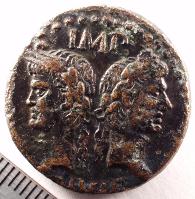
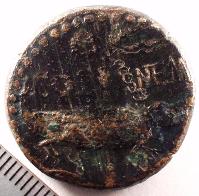
-
A set of six bronze coins of Constantine the Great and family.
No legend on the obverse, only on the reverse.
The obverses show Constantine, his mother, his wife, and three of his four sons;
no issue was made for Constans, the youngest son.
Antioch was the only mint to produce all six designs;
other mints produced only some types.
This recent aquisition completed Mark's type set.
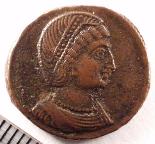
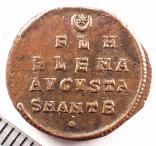
- As a followup to his talk in January, Dennis Fuller showed a patriotic 1863 Army & Navy token in nice condition. In addition to his interest in the Civil War, Dennis has been collecting commemorative coins for more than 20 years, and showed a 1975 Paul Revere commemorative from the American Revolution Bicentennial.
-
In honor of tonight's program Bob Leonard showed a "1652" Pine Tree shilling, made
by John Hull in Boston circa 1675-1682 (Noe 16).
He also showed a copy of Noe's monograph, The Pine Tree Coinage of Massachusetts,
and Madam Knight's Journal of 1704, which describes Pine Tree coins being in circulation then,
over 20 years after the mint closed.
Since his Pine Tree shilling is holed in
the center, which is most unusual, he brought his Charles I halfcrown of
1643 (which was pierced in the center to allow continued circulation, in
1695, and shown at our February meeting) for comparison.
He would be
interested to learn whether anyone thinks that the center piercing on the
Pine Tree shilling indicates use in ENGLAND in 1695.
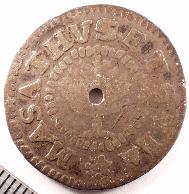
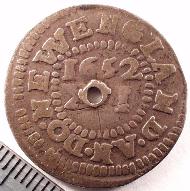
-
Sharon Blocker started off by showing a 1928 one dollar silver certificate
found by her grandfather while cleaning an old locker in the attic.
Other items shown included:
- A 1965 Churchill crown from Great Britain. Sharon was attracted to the piece by the low relief of the design.
- A blue titanium coin produced by the Pobjoy mint in 2000 for Gibraltar, commemorating the 160th anniversary of penny postage.
- A ½ crown from Gibraltar, bearing a hologram. While advertised and sold as a 1 crown piece, the denomination is ½.
-
We all know Drew Michyeta as a collector of coins showing the Statue of Liberty.
He showed the most recent piece, the commemomorative state quarter for New York,
and mentioned that he had been uncertain whether or not the stutue would appear on the
New York quarter; seeing as how the statue is located in the state of New Jersey.
Drew also told us of the planned future reverse designs for the US platinum pieces. Instead of his prevously predicted "eagle over Rockies" we will see an "eagle over cactus," and instead of an "eagle over the Golden Gate" we will see "eagle picking up a seal or something from the water." Drew did not seem happy with the announced designs. -
Carl Wolf continued on his theme of primitive money by showing
a piece of Hoe Money from Nigeria.
This hoe-shaped iron plate was a common form of currency in Nigeria from ancient times into the nineteenth century.
It came in many shapes and frequently played an important part in the negotiations when a wife was purchased.
The shown piece differed in style from the piece Carl showed
a few months ago.
Carl then showed the recently published 4th edition of a book, by Charles Opitz, on primitive money. This edition lacks prices (which are included in a supplement), but it is well illlustrated. -
Bob Feiler
showed his varied interests with:
- A Davey's Token acquired on a recent trip to Scranton, Pennsylvania; it shows a coal mine cart, but shows no value.
-
1652 Mass. Pine Tree Shilling BOX DOLLAR, manufactured for the New
England 1920's Tercentenary celebration.
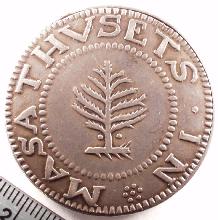
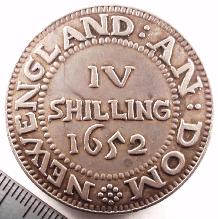
- 80 cent odd denomination scrip from Southern Mining Company of Colmar, Kentucky.
- $50 Bill 1850's Citizens bank of Louisiana; hand colored (1973 reprint?).
- Set of six denominations "De La Rue" test notes brightly colored. Denominations of $1, $5, $10, $20, $50 and $100; possibly test notes for the proposed new United States Currency?
-
Another member continuing themes from past meetings was Don Dool with:
-
Peruvian provisionals
-
1822 Quarto de Real.
Obverse: Radiate sun.
Reverse: ???PROVISIONAL??? 1822, ¼ in field.
Krause 135;
Craig 121;
Eklund 253;
Medina 158.
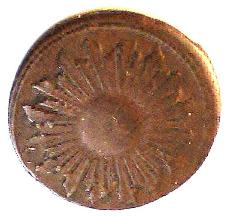
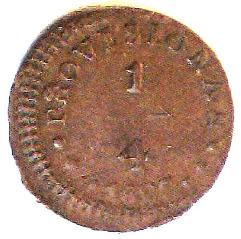
-
1823 Octavo de Peso.
Obverse: Llama before mountains, liberty staff to left, sun in rays above.
Reverse: REPUBLICA PERUNA; M (monogram of Lima mint mark); 1823. In center,
OCTAVO DE PESO.
Krause 137;
Eklund 254.
This is not one of the 1923 restrikes using the original dies,
as those ugly pieces are struck from very rusted dies.
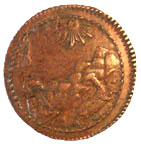
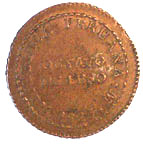
-
1823 Quarto de peso.
Krause 138;
Eklund 255.
Obverse: Llama before mountains, liberty staff to left, sun in rays above.
Reverse: REPUBLICA PERUNA; M; 1823. In center,
QUARTO DE PESO.
The Liberty staff is said to honor Jose de San Martin who had been Protector of Peru.
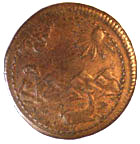
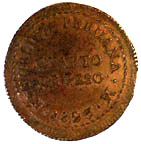
-
1822 Quarto de Real.
Obverse: Radiate sun.
Reverse: ???PROVISIONAL??? 1822, ¼ in field.
Krause 135;
Craig 121;
Eklund 253;
Medina 158.
-
A uniface copper token with a large 2 in the center with the legend, BRAUGENOSSEN ZEULEENRODA
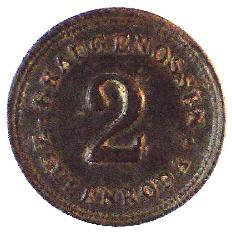
- A fantasy piece made from the obverse of a silver Netherlands ten cent coin, either 1898 or 1901, and the obverse of an 1870 Spanish centimo.
-
Peruvian provisionals
- Our guest for the evening, Steve Huber, showed a recent acquisition: a 3 ducat gold piece from Munster (1661-1678) featuring a bust of Charlemagne on one side.
- Jeff Rosinia concluded the program by showing the closest approximation to an Easter bunny he could find; a silver one-ounce piece from Australia honoring the Year of the Rabbit.
Our 988th Meeting
| Date: | May 9, 2001 |
| Time: | 7:00 PM |
| Location: | Downtown Chicago |
| Featured speaker: | Steve Feller - Bank Notes from the Vault |
| In this presentation banknote enthusiast Steve Feller will tell of every collector's dream phone call. It went something like this from the Coe College business office, "We were searching the vault and came across a tattered envelope with some old bank notes in it. Would you be interested in seeing them?" Was he?! After ascertaining that the first note in the bunch was a Continental Currency note of 1778 issued in Baltimore Steve's appetitie was whetted. There were over a dozen interesting notes which will be described. They came from around the world. The rest of the story will also be told in which a folded letter in the vault from B. Max Mehl in 1932 led to the identity of the collector and his most interesting relationship to the college. |
Important Dates
| May | 9 | CCC Meeting - Featured Speaker - Steve Feller on Bank Notes from the Vault |
| June | 13 | CCC Meeting - Featured Speaker - Tom DeLorey on 1943 Bronze Cents and 1944 Steel Cents |
| July | 11 | CCC Meeting - Featured Speaker - Bob Leonard on Fruit Picker Tokens from Coast to Coast |
Birthday and Year Joined
| June | 1 | Russ Reaves | 1995 |
| June | 7 | Harlan J. Berk | 1995 |
| June | 11 | Joseph A. Piekarczyk | 1991 |
| June | 12 | Rosalind Ryant | 1977 |
| June | 27 | James Simek | 1973 |
Chatter Matter
CHICAGO COIN CLUB
P.O. Box 2301
CHICAGO, IL 60690
Visit Our Web Site
http://www.ece.iit.edu/~prh/coins/ccc.html
Contacting Your Editor
| Paul Hybert
ECE Dept, IIT 3301 S. Dearborn Chicago, IL 60616 |
| prh@ece.iit.edu |
| 1-312-567-3976 |
Club Officers
| Carl Wolf | - President |
| Robert Feiler | - First Vice President |
| Donald Dool | - Second Vice President |
| Directors: | Lyle Daley
William Burd Jeff Rosinia Mark Wieclaw |
| Other positions held are: | |
| Lyle Daley | - Secretary Treasurer |
| Paul Hybert | - Chatter Editor |
| Phil Carrigan | - Archivist |